The Helicobacter Pylori Testing Market is estimated to be valued at USD 214.4 million in 2025 and is projected to reach USD 437.9 million by 2035, registering a compound annual growth rate (CAGR) of 7.4% over the forecast period.
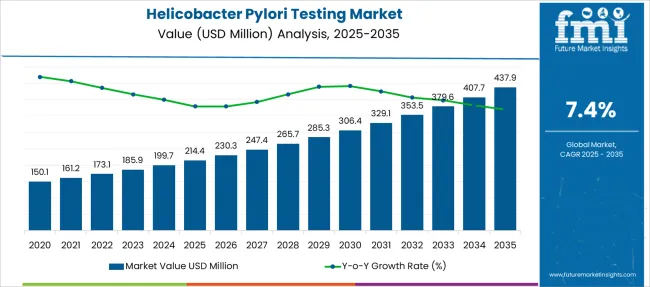
| Metric | Value |
|---|---|
| Helicobacter Pylori Testing Market Estimated Value in (2025 E) | USD 214.4 million |
| Helicobacter Pylori Testing Market Forecast Value in (2035 F) | USD 437.9 million |
| Forecast CAGR (2025 to 2035) | 7.4% |
The Helicobacter pylori testing market is expanding steadily as awareness of the infection’s link to gastrointestinal diseases increases globally. Growing emphasis on early diagnosis and effective treatment of gastric ulcers and cancers has driven demand for reliable testing methods. Medical institutions and healthcare providers have been adopting more advanced diagnostic techniques to improve patient outcomes and reduce complications.
Technological advancements in testing accuracy and turnaround times have further encouraged wider clinical adoption. Increasing healthcare expenditures and screening programs in both developed and emerging markets are also contributing to market growth.
Public health initiatives focusing on infection control and management have supported increased testing rates. Moving forward, the market is expected to grow with innovations in non-invasive testing and integration with digital health platforms. Segmental growth is likely to be led by testing conducted with endoscopy for its diagnostic precision and hospitals as the primary end users.
The market is segmented by Test Type and End User and region. By Test Type, the market is divided into With Endoscopy and Without Endoscopy. In terms of End User, the market is classified into Hospitals, Private Labs, Public Health Labs, and Physician Offices. Regionally, the market is classified into North America, Latin America, Western Europe, Eastern Europe, Balkan & Baltic Countries, Russia & Belarus, Central Asia, East Asia, South Asia & Pacific, and the Middle East & Africa.
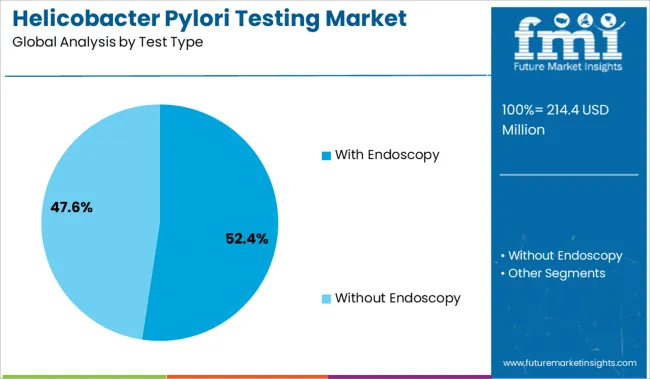
The With Endoscopy test segment is projected to hold 52.4% of the Helicobacter pylori testing market revenue in 2025, leading the test type category. This segment has gained prominence due to its ability to provide direct visualization and biopsy samples from the stomach lining, enabling accurate detection of the infection.
Clinicians prefer endoscopic testing especially in symptomatic patients and those with complicated gastrointestinal conditions. The precision offered by endoscopy allows for combined diagnosis and treatment planning in a single procedure.
Additionally, the availability of advanced imaging and molecular analysis during endoscopy has improved diagnostic confidence. Despite being more invasive than other methods, the diagnostic value of endoscopy has maintained its position as a preferred test type in hospital settings. As the focus on accurate and early detection continues to grow, the With Endoscopy segment is expected to maintain its market leadership.
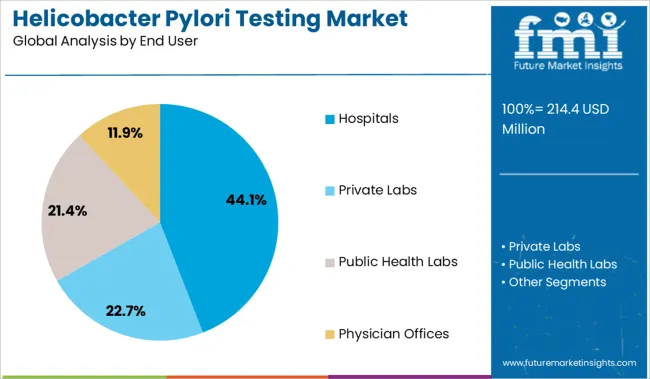
The Hospitals segment is projected to contribute 44.1% of the Helicobacter pylori testing market revenue in 2025, securing its place as the leading end user. Hospitals have been at the forefront of adopting comprehensive diagnostic protocols due to their equipped facilities and trained personnel.
The segment has benefited from increased inpatient and outpatient testing as gastrointestinal diseases continue to pose a significant health burden. Hospitals are preferred for complex cases requiring endoscopy and confirmatory testing.
Furthermore, integrated healthcare delivery systems and specialist gastroenterology departments have streamlined patient referral and testing processes within hospitals. Rising patient volumes and awareness of H. pylori’s role in gastric diseases have contributed to consistent growth in hospital-based testing. With ongoing emphasis on early detection and disease management, the Hospitals segment is expected to retain its dominant role.
The global helicobacter pylori testing industry is poised to increase consistently over the forecast period due to an aging population and an increase in the prevalence of infectious diseases and gastritis. People's growing awareness of immunodiagnostics, rapid advances in technology and innovation, and increasing product approvals are anticipated to propel the global helicobacter pylori testing market forward.
The advancement of newer innovations to enhance accuracy and precision has stemmed from a preference for non-invasive testing. Furthermore, non-invasive tests allow for multiple sample screenings at the same time, which a ects its acceptance rate. Reduced time, reduction of other infections during invasive testing, and less severe pain will all encourage more people to use non-invasive testing.
However, high test costs and a lack of awareness about helicobacter pylori testing are major factors restricting the growth of the global helicobacter pylori testing market.
Underdeveloped and developing countries face challenges related to a lack of healthcare resources. This results in limited access to healthcare services with insufficient facilities, which increases the likelihood of a lack of knowledge about such diseases and their diagnosis.
The market for Helicobacter pylori testing in North America is expected to take a turn for the better, attributed to the growing prevalence of H. pylori infections, rising awareness about disease diagnosis and treatment, and government initiatives to eradicate the incidence of infections.
The bacteria pose a high risk of stomach cancer, contributing to the existing disease burden, and are thus bound to grow the associated incidence and mortality among African Americans in the United States. Furthermore, advances in diagnostic technology and the inclusion of advanced healthcare infrastructure will fuel the country's growth. According to Future Market Insights, North America is likely to account for a 36.4% market share as of 2025.
According to the National Institute of Diabetes and Digestive and Kidney Diseases (NIDDK), approximately half of the people over the age of 60 and 20% of people under the age of 40 are infected with Helicobacter Pylori in the United States. Furthermore, technological advancements in Helicobacter pylori diagnostics, as well as the presence of a well-established healthcare infrastructure, are fuelling the market's growth to a large extent.
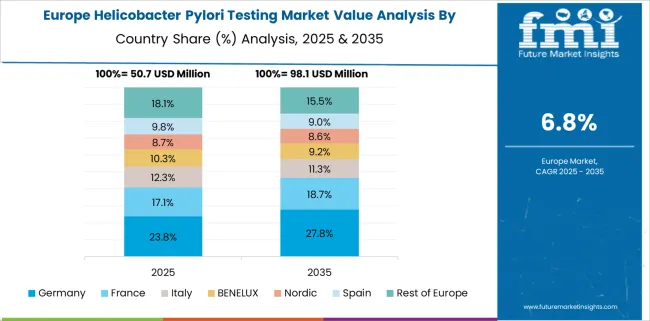
Europe is thought to have the second-largest H. pylori testing market share, accumulating 32% revenue as of 2025. An important factor is the widespread utilization of antibiotics in many countries. In addition, rising investments and the presence of various key players are being evaluated to drive market growth.
The European market for helicobacter pylori testing is expected to be the second largest. The increasing patient pool intent on early detection of helicobacter pylori infection to avoid peptic ulcers is expected to aid market growth in the European region.
The role of H pylori in gastritis, peptic ulcers, and gastric cancer is now established, but research currently underway into possible associations with cardiovascular disease and several other conditions could guarantee a massive market in Europe for H pylori diagnostic tests and antimicrobial eradication therapy.
According to the National Institute for Health Research, the ubiquity of Helicobacter pylori is intense in most countries, including North European populations, where approximately one-third of adults are still infected, whereas, in South America, Asia, and south and east Europe, the prevalence is greater than 50%. Furthermore, Helicobacter pylori remain highly prevalent in immigrants from Helicobacter pylori-endemic countries in Europe. These factors are anticipated to propel the global helicobacter pylori testing market forward in Europe.
The swelling dispersion of start-ups in the Helicobacter Pylori Testing market has improved product quality and expanded global sales. Besides, to gain a competitive edge, new start-ups are working on innovative developments and launching new products such as:
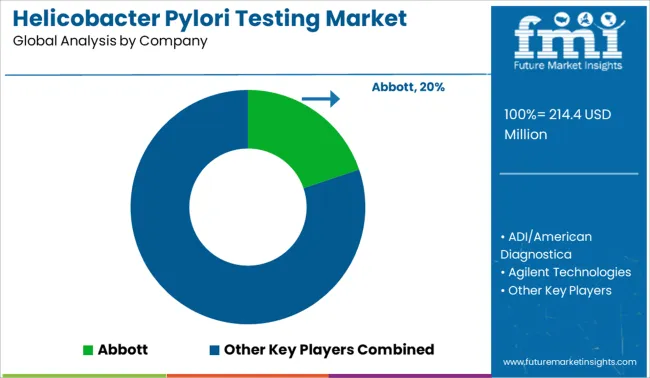
Some key players in the Helicobacter Pylori Testing packaging market are Abbott, ADI/American Diagnostica, Agilent Technologies, Bio-Rad Laboratories, Inc., Helena Laboratories, Horiba, Takara Bio, EKF Diagnostics, Exalenz Bioscience Ltd. and Sekisui Diagnostics, LLC. A key development in the Helicobacter Pylori Testing Packaging market is as follows:
In July 2025, Bio-Rad released Platelia H. pylori IgG, an immuno-enzymatic assay for the qualitative determination of IgG antibodies. Serology provides a non-invasive, sensitive, and simple method for determining H. pylori infection. Platelia H. pylori IgG is an immunoenzymatic assay for determining the quality of IgG antibodies.
| Report Attribute | Details |
|---|---|
| Growth Rate | CAGR of 7.4% from 2025 to 2035 |
| Market Value in 2025 | USD 173.1 Million |
| Market Value in 2035 | USD 380.3 Million |
| Base Year for Estimation | 2024 |
| Historical Period | 2020 to 2024 |
| Forecast Period | 2025 to 2035 |
| Quantitative Units | Revenue in USD Million and CAGR from 2025 to 2035 |
| Report Coverage | Revenue Forecast, Company Ranking, Competitive Landscape, Growth Factors, Trends, and Pricing Analysis |
| Segments Covered | Test Type, End Use, Region |
| Regions Covered | North America; Latin America; Europe; Asia Pacific; Middle East and Africa |
| Key Countries Profiled | United States of America, Canada, Brazil, Mexico, Germany, United Kingdom, France, Spain, Italy, China, Japan, South Korea, Malaysia, Singapore, Australia, New Zealand, GCC Countries, South Africa, Israel |
| Key Companies Profiled | Abbott Laboratories; ADI/American Diagnostica; Agilent Technologies; Bio-Rad Laboratories, Inc.; Helena Laboratories; Horiba; Takara Bio; EKF Diagnostics; Exalenz Bioscience Ltd.; Sekisui Diagnostics, LLC |
| Customization | Available Upon Request |
The global helicobacter pylori testing market is estimated to be valued at USD 214.4 million in 2025.
The market size for the helicobacter pylori testing market is projected to reach USD 437.9 million by 2035.
The helicobacter pylori testing market is expected to grow at a 7.4% CAGR between 2025 and 2035.
The key product types in helicobacter pylori testing market are with endoscopy, _histology, _rapid urease testing, _pcr (polymerase chain reaction), _culture testing, without endoscopy, _stool/faecal antigen test, _urea breath test and _h. pylori antibody testing.
In terms of end user, hospitals segment to command 44.1% share in the helicobacter pylori testing market in 2025.






Full Research Suite comprises of:
Market outlook & trends analysis
Interviews & case studies
Strategic recommendations
Vendor profiles & capabilities analysis
5-year forecasts
8 regions and 60+ country-level data splits
Market segment data splits
12 months of continuous data updates
DELIVERED AS:
PDF EXCEL ONLINE
Helicobacter Pylori Non-Invasive Testing Market Size and Share Forecast Outlook 2025 to 2035
Helicobacter Pylori Infections Treatment Market Size and Share Forecast Outlook 2025 to 2035
Testing, Inspection & Certification Market Growth – Trends & Forecast 2025 to 2035
5G Testing Market Size and Share Forecast Outlook 2025 to 2035
AB Testing Software Market Size and Share Forecast Outlook 2025 to 2035
5G Testing Equipment Market Analysis - Size, Growth, and Forecast 2025 to 2035
Eye Testing Equipment Market Size and Share Forecast Outlook 2025 to 2035
HSV Testing Market Size and Share Forecast Outlook 2025 to 2035
IoT Testing Equipment Market Size and Share Forecast Outlook 2025 to 2035
HPV Testing and Pap Test Market Size and Share Forecast Outlook 2025 to 2035
GMO Testing Services Market Insights – Food Safety & Regulatory Compliance 2024 to 2034
GMP Testing Services Market
LTE Testing Equipment Market Growth – Trends & Forecast 2019-2027
Drug Testing Systems Market Size and Share Forecast Outlook 2025 to 2035
Sand Testing Equipments Market Size and Share Forecast Outlook 2025 to 2035
Tire Testing Machine Market Size and Share Forecast Outlook 2025 to 2035
Self-Testing Market Analysis - Size, Share, and Forecast 2025 to 2035
Food Testing Services Market Size, Growth, and Forecast for 2025–2035
Bend Testing Machine Market Growth - Trends & Forecast 2025 to 2035
An Analysis of the Leak testing Machine Market by Detectors and Sensors Hardware Type through 2035

Thank you!
You will receive an email from our Business Development Manager. Please be sure to check your SPAM/JUNK folder too.
Chat With
MaRIA